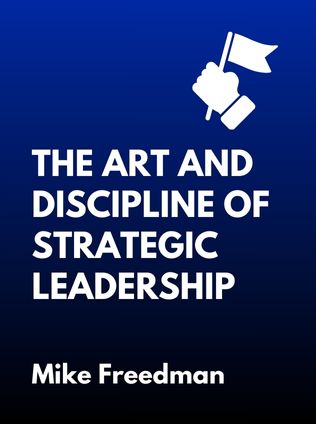
The Art and Discipline of Strategic Leadership
By Mike Freedman
Published 07/2004
About the Author
Mike Freedman is a distinguished expert in strategic leadership, serving as the president of the worldwide strategy practice at Kepner-Tregoe, Inc. With a rich background in consulting and strategic management, Freedman has been instrumental in helping organizations around the world develop and execute effective strategies. His extensive experience in the field has made him a sought-after speaker and advisor. Benjamin B. Tregoe, the co-author, is the co-founder of Kepner-Tregoe, Inc. Tregoe has been a pioneer in the field of strategic problem-solving and decision-making. Together, their combined expertise offers invaluable insights into the complexities of strategic leadership.
Main Idea
In "The Art and Discipline of Strategic Leadership," Freedman and Tregoe provide a comprehensive guide to developing and executing a robust strategy within an organization. The book emphasizes the dual importance of creativity and discipline in strategic leadership. The authors argue that in the rapidly changing landscape of the 21st century, CEOs and leaders must not only create a strategic vision but also ensure its effective implementation and continuous review. The Kepner-Tregoe five-phase model, presented in the book, outlines a structured approach to strategy formulation and implementation. This model serves as a roadmap for organizations seeking to develop a clear strategic direction and maintain it through ongoing evaluation and adjustment.
Table of Contents
- Beyond Vision
- Preparing for Strategic Leadership
- Phase 1: Strategic Intelligence Gathering and Analysis
- Phase 2: Strategy Formulation
- Phase 3: Strategic Master Project Planning
- Phase 4: Strategy Implementation
- Phase 5: Strategy Monitoring, Reviewing, and Updating
Beyond Vision
The opening chapter delves into the fundamental question of what strategy truly means. Freedman defines strategy as "the framework of choices that determine the nature and direction of an organization." This framework includes defining the boundaries and scope of business activities, the key capabilities needed, and the character or nature of the organization. For example, companies like Intel and McDonald's have clear strategic natures—Intel's focus on semiconductor technology and McDonald's emphasis on fast food chains. These characteristics provide coherence to decision-making and communication within the organization.
Strategic decisions are distinguished from routine decisions by their impact on the organization's framework. They are not simply long-term or high-cost decisions but are choices that fundamentally alter the organization's course. Freedman emphasizes that a strategic vision must be rooted in facts, informed assumptions, and the best-possible what-if thinking. It is not enough to set a direction; the vision must be communicated throughout the organization to ensure alignment and must be continuously monitored for strength, agility, and relevance.
"A company without a coherent strategy is particularly vulnerable," Freedman asserts, highlighting the risks of lacking a clear direction in today's competitive landscape.
The authors argue that the art of creativity and the discipline of execution are both essential in strategy. While creativity is necessary to fashion a vision, discipline is required to turn that vision into reality. Executives must actively create a strategy rather than defaulting to an inherited or copied one. This proactive approach shields the organization from external threats and internal confusion.
Sign up for FREE and get access to 1,400+ books summaries.
You May Also Like
The Lean Startup
How Today's Entrepreneurs Use Continuous Innovation to Create Radically Successful Businesses
By Eric RiesWho Moved My Cheese?
An Amazing Way to Deal with Change in Your Work and in Your Life
By Spencer Johnson, M.D.Make Your Bed
Little Things That Can Change Your Life...And Maybe the World
By William H. McRavenThe Ride of a Lifetime
Lessons Learned from 15 Years as CEO of the Walt Disney Company
By Robert IgerThe Hard Thing About Hard Things
Building a Business When There Are No Easy Answers
By Ben Horowitz



















